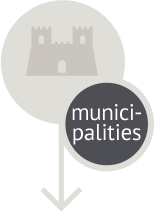THE WALLS
Trea, Montecchio, Treia, 25 centuries of history from the Roman age to Middle Ages and Modern age. From the boulevard that coasted the walls, the view goes from Monte Conero to Sibillini. Castled walls that remind us XIII century, the age of “Beato Pietro da Treia”, of whom it is spoken in Fioretti di San Francesco and Federico II, whose son Enzo managed vainly to conquer them throughout Corrado d’Antiochia. The people of Treia won him at Door Vallesacco, that raises itself as the Tower of Onglavina: extreme bastion of the City towards south that hails from the Lombard period.
The structure of the City born in the XI century. The castles of Onglavina, Elce and Cassero, which raised on three hills of the village, were become fortress that faced the enemy attacks. A big lineal axis on the crest of the hill where the lowest point was on the north (Door Saint Martino) and the highest one on the south (Door Saint Michele), crossed the three hills raising from two irregular rises diagonally, from Door Vallesacco on the east and from Door Montana on the west, linked with the principal axis and a third raised diagonal opposed to Door Montana. Parallel to the principal axis, many little streets which crossed the diagonals, named today “via Montegrappa” and “via Garibaldi”. The city had an rural aspect with vegetable gardens, small vineyards, trees, glades and free animals. As vestiges of her Middle-Ages period, Treia conserves some towers yet: the Tower of Onglavina (or of Saint Marco), the Tower of Mill, the “Roccaccia” (the only ruin of Monte Acuto) and the Casone, a tower-house situated in Collevago.
«Non seppi mai che Treja fosse una città murata; che le Mura di chiamassero cosi perché giravano all'esterno dell'antica muraglia».
«Le Mura di levante erano un balcone sinuoso: davanti a ondulazioni collinose, valli di fiumi, vallicelle di torrenti, lontanissimo l'orizzonte: linea interrotta dalla gobba del Conero e da paesi sopraelevati come diademi turriti; brillio di lumi palpitanti la notte. Un incavo nel mezzo della linea riempito da un chiarore: il mare, mai in sintonia col cielo, sempre più chiaro, o più scuro. In quella conca di mare chi aveva vista acuta scorgeva un cupolone come quello di San Pietro: la casa della Madonna».
Da “Giù la piazza non c’è nessuno” di Dolores Prato
THE DOORS
The doors of Treia walls are full of history and legends. As for example Door Montana, where Saint Nicola resuscitated a child in 1271, or as at Door Vallesacco (national monument) where the City, called Montecchio, defeated and captured Corrado d’Antiochia in 1263.
A letter of 31th August 1392 tell us about a ballot of who would be become keepers of the Doors. This document testify the number and the name of the doors of Montecchio: Porta Nuova, Porta degli Elci (Porta Roma) Porta di Bonasera, Porta San Giovanni (today Porta San Martino, that is the lower point of the city in the north), Porta di Maestro Petruzio, Porta S. Ecgidio (that today is called Palestro). Of the nine original doors, today remain Porta Vallesacco, Porta Palestro and Porta San Martino, Porta Cassara (called in this way reminding the ancient Castle of Cassero) has features of XVIII century, while Porta Roma is a new edition of a door of XIV century, situated in the area of Elci Castle.





